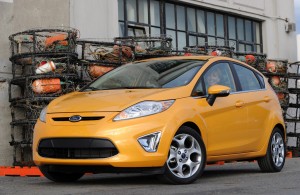
Ford is now ready to go it alone without the help of long-time ally Mazda when developing replacements for products like the 2011 Fiesta.
Ford Motor Co. appears ready to sell off most or all of its remaining stake in Japan’s Mazda Motor Corp., several industry sources have confirmed.
Such a move would not only relinquish Ford’s role as the largest Mazda shareholder but also end what has been the longest in-depth relationship between a U.S. and Japanese automaker – one that has helped both makers develop an array of products that might not have been able to bring to market on their own.
The sale, if completed, would mark another milestone in Ford CEO Alan Mulally’s so-called One Ford strategy, which has already led the U.S. maker to sell off an assortment of foreign luxury brands, including Jaguar, Land Rover and Volvo.
In fact, one of Mulally’s first big moves, in 2008, shortly after joining the Detroit maker, was to cut Ford’s stake in Mazda from 33.4% to 13%. That figure has since declined to 11%.
“We’re not commenting about reports on our shareholding in Mazda,” Ford spokesman Mark Truby told TheDetroitBureau.com. “We have a close relationship with Mazda,” he added, “that spans 30 years.”
But other sources, both in the U.S. and Japan, told TheDetroitBureau.com that Ford is, indeed, negotiating a sell-off of its remaining stake – which was once large enough that the U.S. maker was able to appoint its own representative to run the Japanese company.
The 2008 equity sale was driven most urgently by Ford’s need for cash. Shortly after joining Ford, in October 2007, Mulally realized the company was facing potential insolvency, especially if the American economy collapsed. He began selling off or mortgaging key assets – a move that ultimately helped the maker survive the 2009 recession without the bankruptcy and bailout needed to save rivals General Motors and Chrysler.
Now, however, Ford seems to simply want to eliminate any remaining management distractions, said one source, who called it a “compelling” reason to sever the ties.
A few years ago, such a break might have seemed difficult. After all, the two companies have worked closely on an array of products, particularly at the small end of the market, for decades, starting with the old Ford Escort.
Even some of Ford’s newest models, like the Fiesta subcompact, have roots leading back to Mazda headquarters, in Hiroshima. But Ford’s product chief, Derrick Kuzak, insists that Mazda’s role in recent models has been diminishing and that the company can now design and engineer a full line-up on its own.
The One Ford strategy is key here, as well, because the maker has switched to global platforms, shared in markets around the world, rather than developing unique products for each key region. The new 2011 Ford Focus is an example. The American version will share about 80% of the parts and components used in the European model.
Other parts of the Ford/Mazda alliance will be severed, notably including their production base in booming China. Mazda is waiting for Chinese approval to split a joint venture with Ford and develop its own production system there.
And it has even turned to Mazda, rather than Ford, for help developing future hybrid-electric vehicles.
But the makers may continue some joint operations, such as the plant they operate in Rayong, a distant suburb of Bangkok, which is producing a new compact pickup. Ford’s version is being sold in most world markets as the Ranger. (Click Here for more.)
While the two companies may be moving apart, a senior source at Ford cautioned, “It’s not a done deal.” He stressed there are a number of obstacles yet to be overcome, including coming up with the appropriate valuation of Ford’s holdings in the Japanese carmaker.
As of Monday, Ford’s 195 million shares would be worth about $516 million. But that figure could vary significantly under any final parting agreement.

I can’t help feeling that cutting the cord with Mazda could be a key mistake on Ford’s part. Mazda is kind of the sleeper of Japanese car companies. Toyota and Honda get all the press, but Mazda makes some interesting cars. And they seem to do great design work on a shoestring budget. Ford, on the other hand, probably wouldn’t have even had any “cars” recently if it wasn’t for Mazda. Crown Vic and Mustang excluded of course.